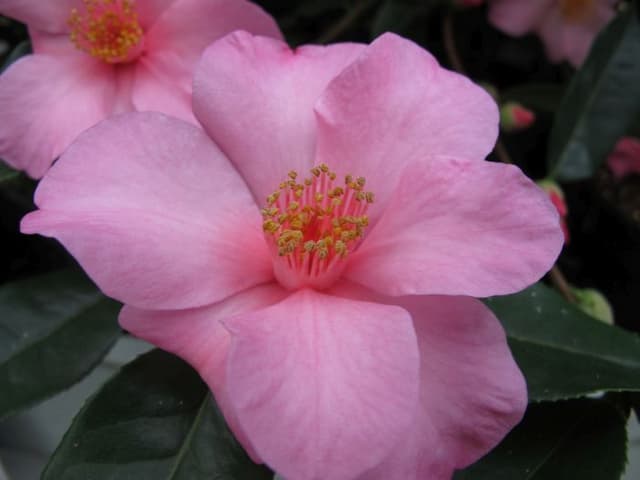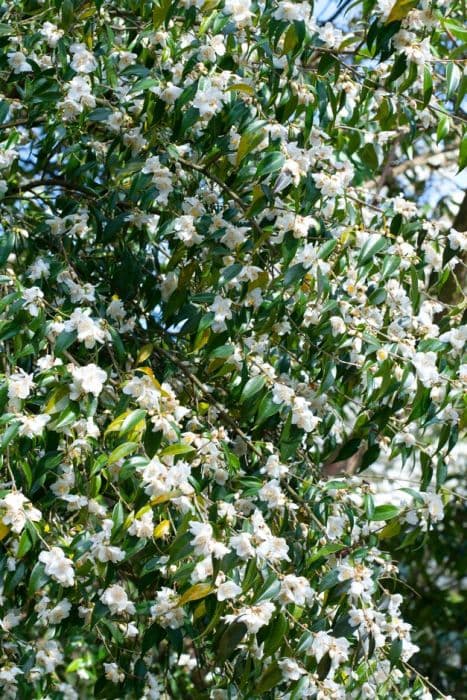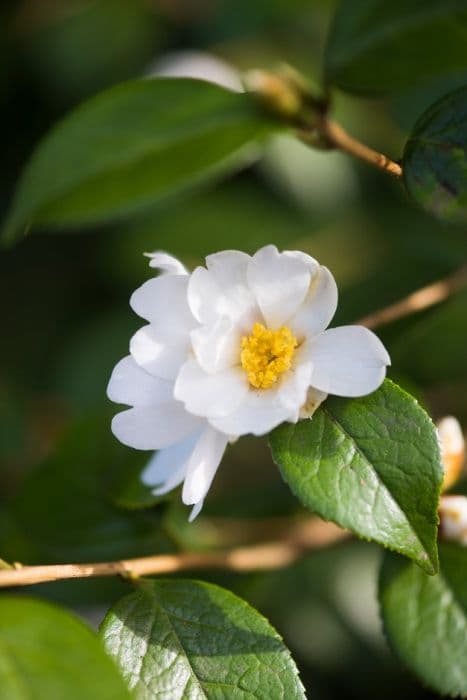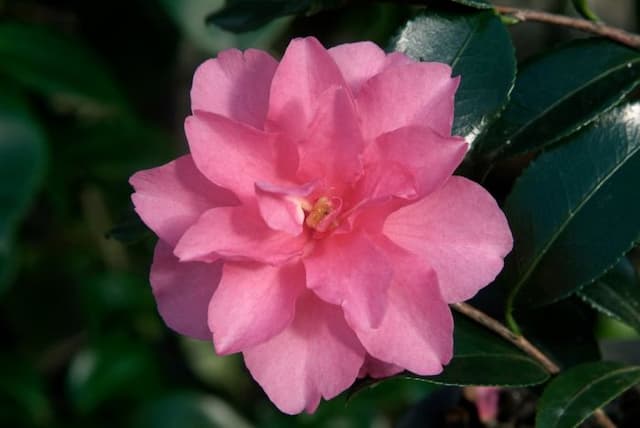Sasanqua Camellia Camellia sasanqua 'Crimson King'

ABOUT
The Camellia sasanqua 'Crimson King' is a lush plant, well-known for its beautiful and striking crimson flowers which make it a standout in any garden. These blooms, deep red in color, exhibit an elegant form, often with ruffled or slightly overlapping petals giving them a graceful, yet bold aesthetic. Each blossom is typically filled with a prominent cluster of golden-yellow stamens at their center, adding a touch of contrast and allure to the flower. The foliage of the 'Crimson King' is equally attractive, composed of glossy, dark green leaves. These leaves have a leathery texture and are oval-shaped with finely serrated edges. They provide a rich backdrop to the vibrant red flowers, further highlighting their beauty. As a plant that changes with the seasons, the 'Crimson King' blooms primarily in the cooler months, bringing color and life to gardens when many other plants have ceased to flower. Its overall appearance is one of elegance and charm, making it a prized specimen for plant enthusiasts and gardeners seeking to make a statement with bold hues and luxurious foliage.
About this plant
 Names
NamesFamily
Theaceae.
Synonyms
Sasanqua Camellia, Christmas Camellia, Winter Blooming Camellia.
Common names
Camellia sasanqua 'Crimson King'.
 Toxicity
ToxicityTo humans
Camellia sasanqua, commonly known as sasanqua camellia, is not considered to be toxic to humans. Ingesting parts of this plant is not typically associated with poisoning or harmful effects. Therefore, there are no well-documented symptoms or consequences from ingestion of sasanqua camellia for humans.
To pets
Sasanqua camellia is also generally considered non-toxic to pets. It is not known to cause poisoning in domestic animals such as cats and dogs if they ingest parts of the plant. So, there are no specific symptoms of toxicity or notable consequences associated with pets consuming sasanqua camellia.
 Characteristics
CharacteristicsLife cycle
Perennials
Foliage type
Evergreen
Color of leaves
Green
Flower color
Crimson
Height
4-12 feet (1.2-3.7 meters)
Spread
4-12 feet (1.2-3.7 meters)
Plant type
Shrub
Hardiness zones
7-9
Native area
Japan
Benefits
 General Benefits
General Benefits- Ornamental Value: Camellia sasanqua 'Crimson King' is known for its beautiful crimson flowers which can enhance the aesthetic appeal of any garden.
- Long Blooming Season: It has a long flowering period from fall to winter, providing color and interest in the garden during a time when few other plants are in bloom.
- Drought Tolerance: Once established, it is relatively drought tolerant, requiring less watering compared to many other ornamental plants.
- Pest Resistance: The plant shows resistance to many common pests, reducing the need for chemical pesticides.
- Shade Tolerance: It can grow well in partial shade, making it a versatile choice for different garden situations.
- Evergreen Foliage: The plant retains its green leaves throughout the year, providing a constant backdrop of foliage in the landscape.
- Privacy Screen: With its dense growth habit, it can be used to create a natural privacy screen or hedge.
- Wildlife Attraction: The flowers attract pollinators such as bees, contributing to the biodiversity of the garden ecosystem.
- Soil Erosion Control: The plant’s root system can help stabilize soil, reducing erosion on slopes.
- Low Maintenance: Camellia sasanqua 'Crimson King' requires relatively low maintenance once established, with only occasional pruning needed to maintain its shape.
 Medical Properties
Medical PropertiesThis plant is not used for medical purposes.
 Air-purifying Qualities
Air-purifying QualitiesThis plant is not specifically known for air purifying qualities.
 Other Uses
Other Uses- As a natural dye: The petals of Camellia sasanqua 'Crimson King' can be used to produce a natural pinkish-red dye for fabric, yarn, or paper.
- Cut Flower Arrangements: The bright and long-lasting flowers are a popular choice to add vibrant color to floral displays and bouquets.
- Bonsai Plant: Due to its attractive form and foliage, this plant can be trained as a bonsai, allowing for the appreciation of its beauty on a miniature scale.
- Privacy Screens: When planted in a row or as a hedge, they can form a dense, evergreen privacy screen for homes or gardens.
- Topiary Art: Its dense growth habit allows for shaping into various unique forms for topiary art.
- Photography: The beauty of the plant, especially when in bloom, makes it a sought-after subject for photographers and artists.
- Garden Design Element: Used as a specimen plant, it can provide a focal point in garden designs, especially in Asian-themed gardens.
- Companion Planting: This plant can be paired with other acid-loving plants like Rhododendrons and Azaleas to create a layered garden effect.
- Craft Material: Dried flowers can be used for crafting, such as in the creation of natural potpourris or decorative arrangements.
- Culinary Decoration: Although not commonly known for its edibility, the non-toxic petals can occasionally be used for a colorful garnish on dishes.
Interesting Facts
 Feng Shui
Feng ShuiThe Camellia is not used in Feng Shui practice.
 Zodiac Sign Compitability
Zodiac Sign CompitabilityThe Camellia is not used in astrology practice.
 Plant Symbolism
Plant Symbolism- Love - Camellia flowers, including the 'Crimson King' variety, often represent love and affection, with their lush and full-bodied blooms symbolizing the depth and intensity of romantic feelings.
- Admiration - The beauty of the Camellia 'Crimson King' can also signify admiration, with its elegant form and richly colored petals inspiring a sense of wonder and respect.
- Perfection - The nearly perfect symmetry and appearances of Camellias have historically been associated with the notion of ideal beauty and perfection, a quality often ascribed to this plant.
- Longevity - As Camellias are evergreen shrubs that can live for many years, they are commonly used to symbolize longevity and enduring life.
- Gratitude - Giving a Camellia is traditionally a way to express gratitude in some cultures, with the 'Crimson King' potentially being a unique and vivid way to say "thank you."
 Water
WaterSasanqua camellias, including 'Crimson King', prefer evenly moist soil, so water them when the top inch of soil feels dry to the touch. This typically means watering once a week, but this can vary based on temperature and humidity. Provide approximately 1 gallon of water per session for smaller shrubs, increasing to several gallons as the plant matures and according to the size of the plant. During hot, dry spells, they may need water twice a week, while in cooler, wet weather, they may need less frequent watering. It's crucial to avoid overwatering and ensure good drainage to prevent root rot.
 Light
LightSasanqua camellias such as 'Crimson King' thrive in partial shade where they can get some morning sun but are protected from the intense afternoon sun. An ideal spot would be under the high, dappled shade of tall trees. They can also adapt to full sun in cooler climates if properly watered.
 Temperature
TemperatureSasanqua camellias, like 'Crimson King', prefer temperatures ranging from 60 to 70 degrees Fahrenheit during the day and 50 to 60 degrees at night. They are cold hardy and can generally tolerate temperatures as low as 20 degrees, but they should be protected from extreme cold snaps. Ideal temperature conditions balance cool nights with warm, but not hot, daytime temperatures.
 Pruning
PruningSasanqua camellias like 'Crimson King' should be pruned to shape the plant, remove dead or weak growth, and encourage air circulation. Pruning should be done after flowering but before new growth starts in late winter or early spring. Light pruning can be done annually, while more extensive reshaping should be tackled every few years to maintain the plant's structure and health.
 Cleaning
CleaningAs needed
 Soil
SoilSasanqua camellia prefers well-draining, acidic soil with a pH between 5.5 and 6.5. A mix of equal parts potting soil, peat moss, and pine bark fines creates a suitable growing medium. Ensuring good drainage is crucial to prevent root rot in these plants.
 Repotting
RepottingSasanqua camellia should be repotted every 2-3 years to ensure the soil remains fertile and well-draining. Younger, actively growing plants may require more frequent repotting than mature, established specimens.
 Humidity & Misting
Humidity & MistingSasanqua camellia thrives in moderate to high humidity levels, ideally between 40% and 60%. They can tolerate lower humidity, but consistent levels within this range help support healthy growth and flowering.
 Suitable locations
Suitable locationsIndoor
Place sasanqua camellia near a bright window, away from direct sun and drafts.
Outdoor
Plant sasanqua camellia in partial shade with shelter from intense afternoon sun.
Hardiness zone
7-9 USDA
 Life cycle
Life cycleCamellia sasanqua 'Crimson King', commonly known as Sasanqua camellia, begins its life cycle as a seed, which germinates to produce a small seedling. The seedling grows into a juvenile plant with tender stems and immature leaves, and as it matures, it develops a woody stem and a more established root system. This evergreen shrub enters a growth phase in which it develops glossy, dark green leaves and eventually buds. Flowering typically occurs in the fall to winter months when the plant produces crimson to deep pink flowers that attract pollinators. After pollination, flowers give way to seed pods that eventually release seeds to restart the life cycle. With proper care, Sasanqua camellia can live for many years, undergoing seasonal cycles of growth, flowering, and dormancy.
 Propogation
PropogationPropogation time
Early spring
The most popular method for propagating Camellia sasanqua 'Crimson King', commonly known as Sasanqua camellia, is through semi-hardwood cuttings. This is usually done in late summer to early fall, when the current year's growth has begun to mature but is not yet fully hardened. To propagate, a gardener would take cuttings of about 4 to 6 inches (10 to 15 centimeters) in length from healthy, non-flowering branches. Each cutting should have at least two sets of leaves at the top, and the lower leaves should be removed. The cut end can be dipped in a rooting hormone to encourage root development and then inserted into a pot filled with a mix of peat and perlite or a similar well-draining medium. The cuttings should be kept moist and in a warm environment with indirect light until roots develop, which can take several weeks.









